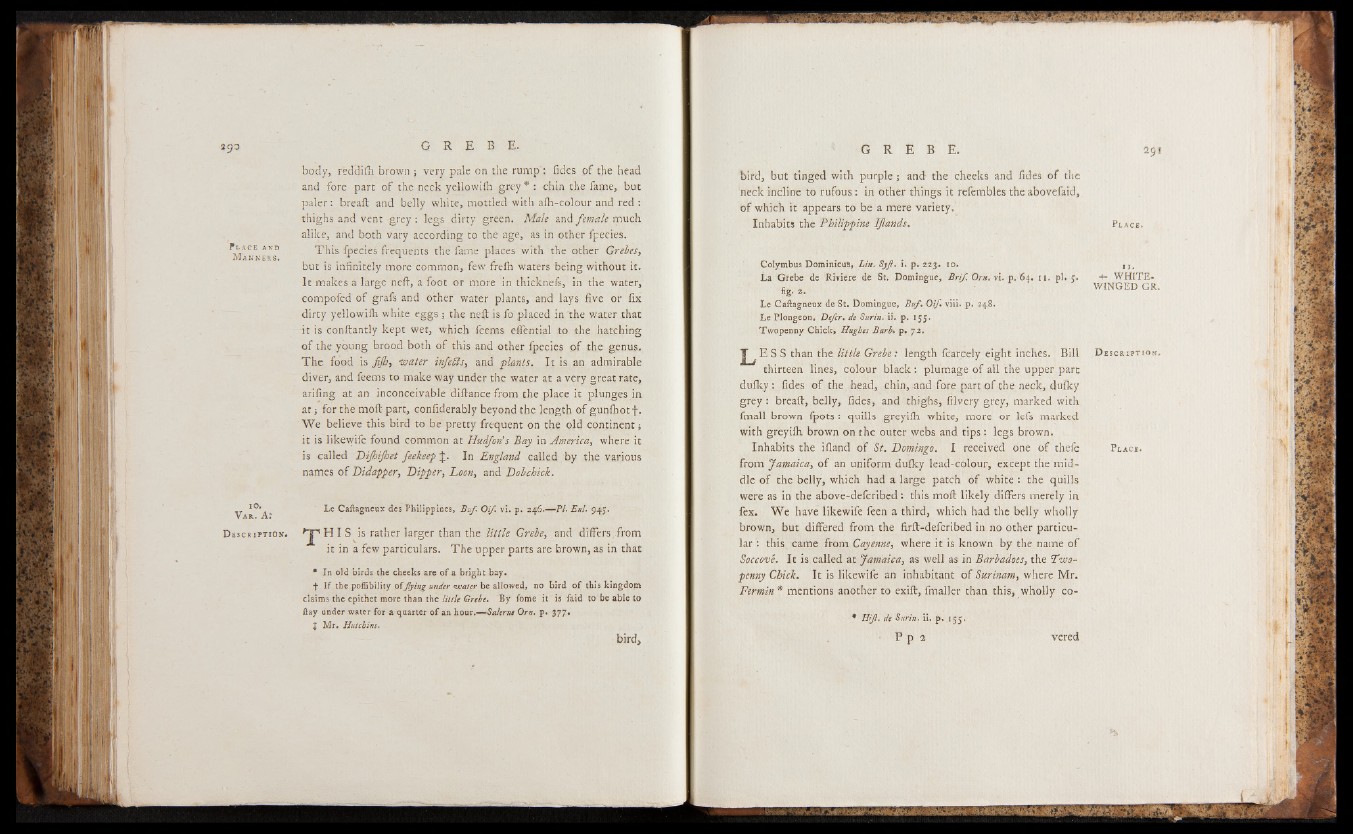
P la ce and
M a nne r s .
10.
V a r . A?
D e s c r i p t io n #
body, red'difh brown ; very pale on the rump : Tides of the head
and fore part of the neck yellowilh grey* : chin the fame, but
paler : breaft and belly white, mottled with afh-colour and red :
thighs and vent grey: legs dirty green. Male and female much
alike, and both vary according to the age, as in other fpecies.
This fpecies frequents the lame places with the other Grebes,
but is infinitely more common, few frelh waters being without it.
It makes a large neft, a foot or more in thicknefs, in the water,
compofed of grafs and other water plants, and lays five or fix
dirty yellowilh white eggs ; the neft is fo placed in'the water that
it is conftantly kept wet, which feems effential to the hatching
of the young brood both of this and other fpecies of the genus.
The food is jijh, water infebls, and plants. It is an admirable
diver, and feems to make way under the water at a very great rate,
arifing at an inconceivable diftance from the place it plunges in
a t ; for the molt part, confiderably beyond the length of gunlhotf.
We believe this bird to be pretty frequent on the old continent j
it is likewife found common at Huijon’s Bay in America, where it
is called Dijhijhet feekeep^. In England called by the various
names of Didapper, Dipper, Loon, and Dobchick.
' Le Caitagneux des Philippines, Buf Oif. vi. p. 246.— PI. Enl. 945.
H I S is rather larger than the little Grebe, and differs from
it in a few particulars. The upper parts are brown, as in that
• In old birds the cheeks are of a bright bay.
f If the poffibility offlying under 'water be allowed, no bird of this kingdom
claims the epithet more than the little Grebe. By fome it is faid to be able to
Hay under .water for a quarter of an hour.— Stderne Qrn. p. 377,
J Mr. Hutchins.
bird.
rnæm
bird, but tinged with purple; and the cheeks and fides of the
neck incline to rufous : in other things it refembles the abovefaid,
of which it appears to be a mere variety.
Inhabits the Philippine IJlands.
Colymbus Dominicus, Lin. Syfi. i. p. 223. 10.
La Grebe de Riviere de St. Domingue, Brif. Orn. vi. p. 64. 1 1, pi. 5.
fig. 2.
Le Caftagneux de St. Domingue, Buf. Oif. viii. p. 248.
Le Plongeon, Defer. de Surin. ii. p. 155.
Twopenny Chick, Hughes Barb* p, 72. 1~ ^ E S S than the little Grebe: length fcarcely eight inches. Bill D e s c r i p t io n .
thirteen lines, colour black: plumage of all the upper part
dulky : fides of the head, chin, and fore part of the neck, dulky
grey : breaft, belly, fides, and thighs, filvery grey, marked with
fmall brown fpots : quills greyilh white, more or lefs marked
with greyilh brown on the outer webs and tips : legs brown.
Inhabits the ifland of St. Domingo. I received one of thefe Pl a c e .
from Jamaica, of an uniform dulky lead-colour, except the middle
of the belly, which had a large patch of white : the quills
were as in the above-deferibed: this mod likely differs merely in
fex. We have likewife feen a third, which had the belly wholly
brown, but differed from the firft-deferibed in no other particular
: this came from Cayenne, where it is known by the name of
Soccove. It is called at Jamaica, as well as in Barbadoes, the Twopenny
Chick. It is likewife an inhabitant of Surinam, where Mr.
Fermin * mentions another to exift, fmaller than this, wholly co-
Hifl. de Surin. ii. p. 155.
P p 2 vered
H I
É 9 |
Pl a c e . W*Sk
i i .
4- WHITEü?
WINGED GR. mm -
m w M mgm V i t
H E
*S4 I
M l
1- § ® |T
HU